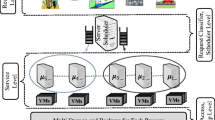Abstract
Currently, information technology is developing rapidly, and resulting in the vigorous development of the IPv6. The new concept of the future network is applied to the smart objects which have sensing, networking and computing abilities, and the ability to transfer data between the objects; the novel network environment is called the Internet of Things (IoT). There are a large number of heterogeneous smart objects in the IoT; thus, the data are huge and complex. The conventional middleware layer in the IoT may result in huge amount of inaccurate information. Thus, a framework of middleware is proposed to filter and integrate the vast amounts of information to be meaningful and available. In addition, a three-phase scheduling under a cloud computational resource layer is proposed in this study to improve the effectiveness of the system. Thereby, each task to be performed can be assigned to the appropriate resources, while improving the load on each service node and reducing the waste of resources.









Similar content being viewed by others
References
Almakdi S, Aleisa M, Alshehri M (2015) Simulation and performance evaluation of CPU scheduling algorithms. Simulation. doi:10.17148/IJARCCE.2015.4301
Amato F, Mazzeo A, Moscato V, Picariello A (2014) Exploiting cloud technologies and context information for recommending touristic paths. In: Intelligent distributed computing VII. Springer, Cham, pp 281–287
Atzori L, Iera A, Morabito G (2010) The internet of things: a survey. Comput Netw 54(15):2787–2805
Bahuguna Y, Punetha D, Verma P (2017) An analytic study of the key factors influencing the design and routing techniques of a wireless sensor network. Int J Interact Multimed Artif Intell:11–15
Chen H, Wang F, Helian N, Akanmu G (2013) User-priority guided Min–Min scheduling algorithm for load balancing in cloud computing. 2013 National Conference on Parallel Computing Technologies (PARCOMPTECH), pp 1–8
Coetzee L, Eksteen J (2011) The Internet of Things-promise for the future? An introduction. IST-Africa conference proceedings, pp 1–9
Dhall R, Solanki V (2017) An IoT based predictive connected car maintenance. Int J Interact Multimed Artif Intell 4(3):16–22
Eisenhauer M, Rosengren P, Antolin P (2010) Hydra: a development platform for integrating wireless devices and sensors into ambient intelligence systems. Internet Things:367–373
García CG, Meana-Llorián D, Lovelle JMC (2017) A review about smart objects, sensors, and actuators. Int J Interact Multimed Artif Intell 4(3):7–10
Guinard D, Trifa V, Karnouskos S, Spiess P, Savio D (2010) Interacting with the soa-based internet of things: discovery, query, selection, and on-demand provisioning of web services. IEEE Trans Serv Comput 3(3):223–235
Li S, Da Xu L, Zhao S (2015) The internet of things: a survey. Inf Syst Front 17(2):243
Luigi A, Antonio I, Giacomo M (2010) The internet of things: a survey. Computer Netw 54:2787–2805
Molano JIR, Lovelle JMC, Montenegro CE, Granados JJR, Crespo RG (2017) Metamodel for integration of Internet of Things, social networks, the Cloud and Industry 4.0. J Ambient Intell Hum Comput:1–15
Shaw SB, Singh AK (2014) A survey on scheduling and load balancing techniques in cloud computing environment. 2014 international conference on computer and communication technology (ICCCT), pp 87–95
Stojkoska BLR, Trivodaliev KV (2017) A review of internet of things for smart home: challenges and solutions. J Clean Prod 140:1454–1464
Teixeira T, Hachem S, Issarny V, Georgantas N (2011) Service oriented middleware for the internet of things: a perspective. Towards Serv Based Internet:220–229
Wang SC, Liao WP, Yan KQ, Wang SS, Chen CW (2011) The study of load balance enhancement in a hierarchical cloud computing environment. Int J Adv Inf Technol 5(2):295–303
Wang SC, Su YH, Wang SS, Yan KQ, Chen SF (2014) Achieving load balance in a hierarchical peer-to-peer architecture. WSEAS Trans Comput 13:107–117
Young P (2015) Central limit theorem, p 55
Author information
Authors and Affiliations
Corresponding authors
Rights and permissions
About this article
Cite this article
Tsai, YT., Wang, SC., Yan, KQ. et al. Availability enhancement in a four-layer based IoT use three-phase scheduling. J Ambient Intell Human Comput 9, 1275–1291 (2018). https://doi.org/10.1007/s12652-017-0605-2
Received:
Accepted:
Published:
Issue Date:
DOI: https://doi.org/10.1007/s12652-017-0605-2




